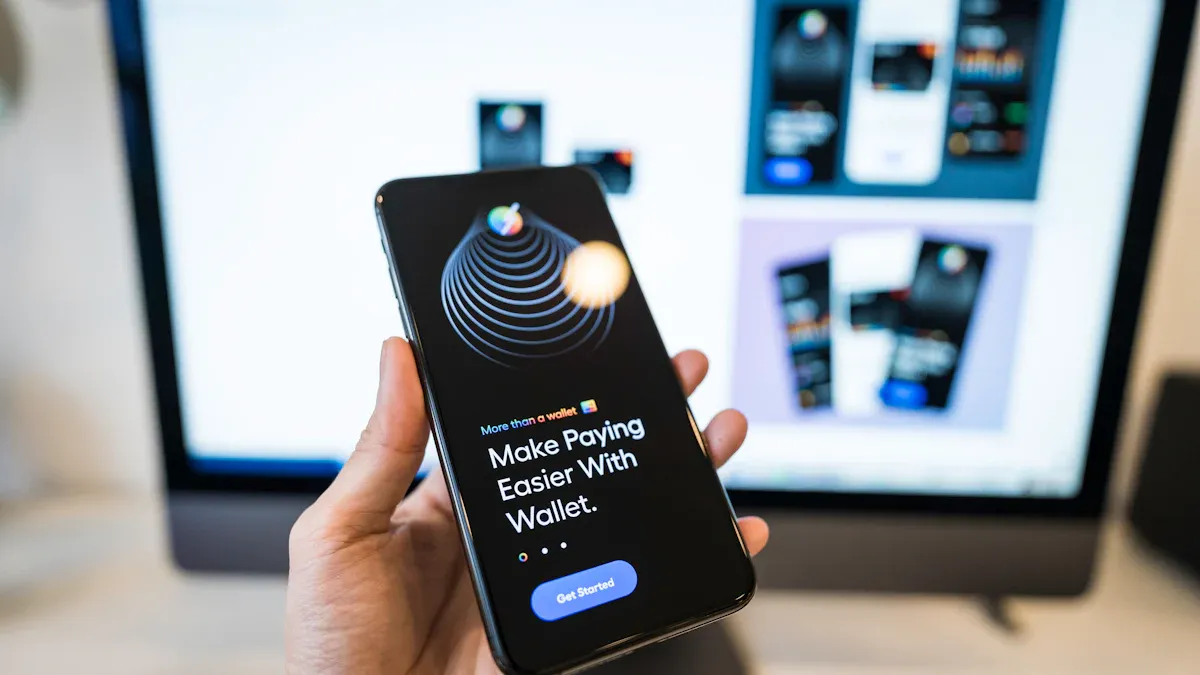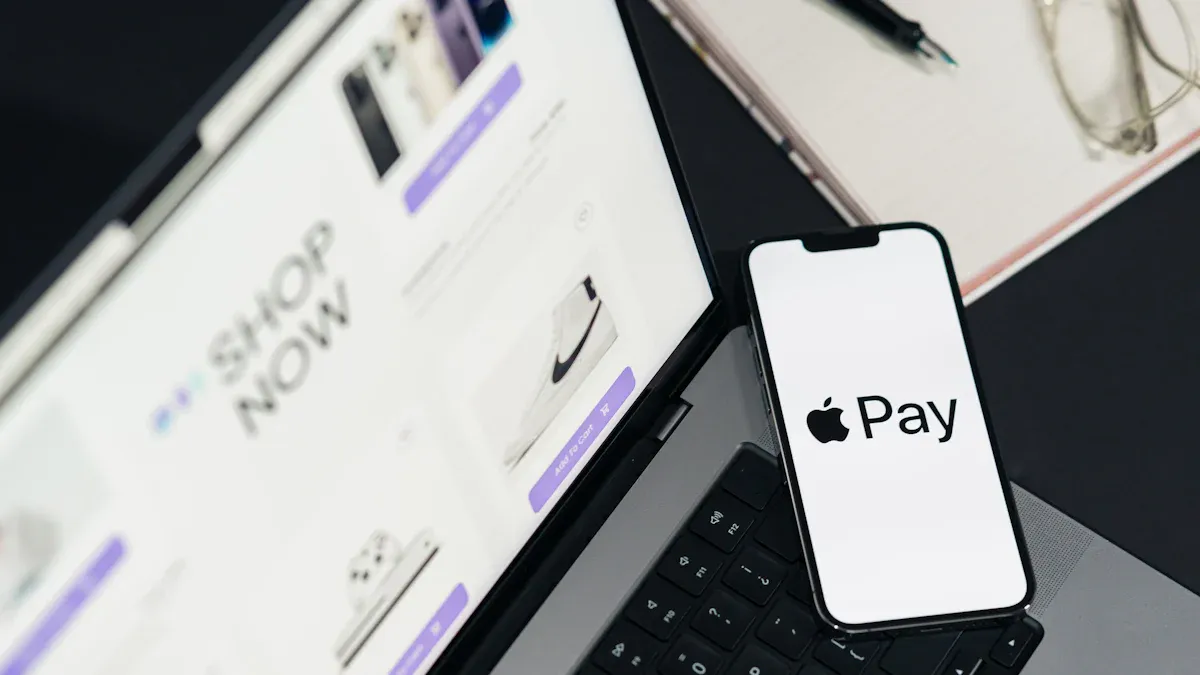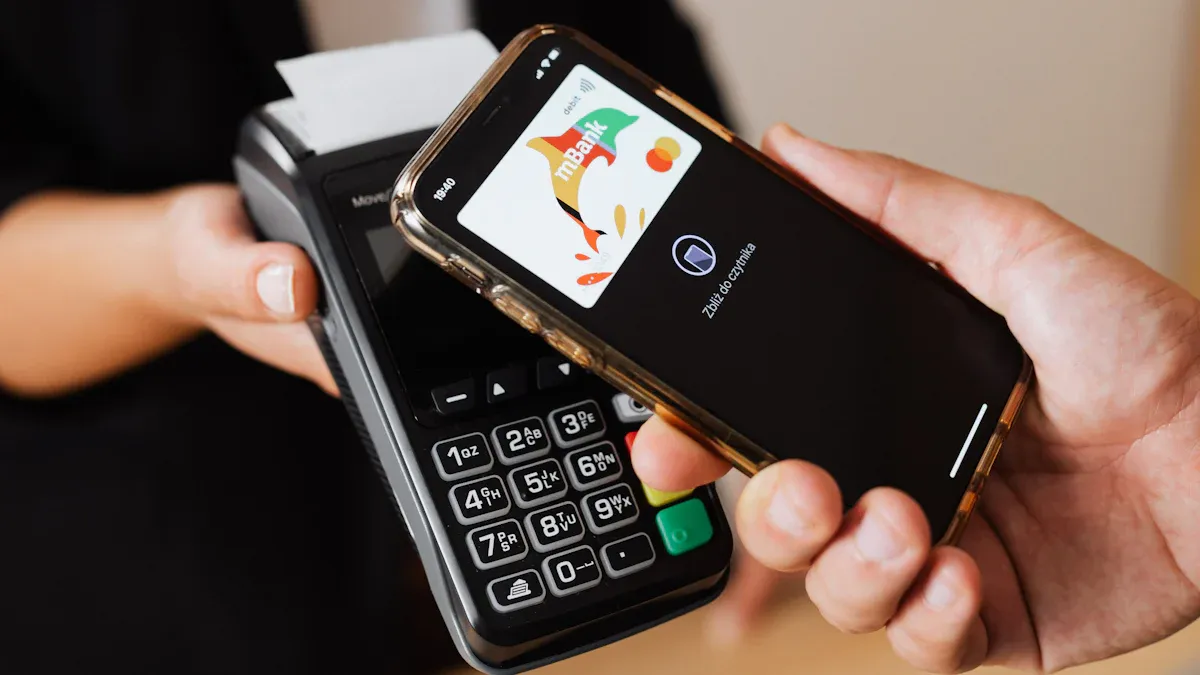- EasyCard
- Trade
- Help
- Announcement
- Academy
- SWIFT Code
- Iban Number
- Referral
- Customer Service
- Blog
- Creator
Details You Must Know Before Using Apple Pay to Pay Someone

Image Source: pexels
You’re probably familiar with the convenience of using Apple Pay for in-store payments. But have you used it to send money to a friend? This is quite different from the common WeChat or Alipay transfers we’re used to.
Before you hit “send,” you need to know where this money is going. How will the recipient receive it? Understanding the Apple Pay payment details can help you avoid many unexpected issues.
Key Takeaways
- The Apple Pay transfer function is integrated into iMessage, and both you and the recipient must use Apple devices with iMessage activated.
- Apple Pay person-to-person transfers are only available in mainland China and can only be made via UnionPay debit cards, not credit cards or for international transfers.
- Apple Pay transfers are typically free and fast, but weekends or holidays may delay receipt.
- Once the recipient accepts the transfer, the transaction cannot be reversed, so always verify details before sending.
- Apple Pay protects your transaction security and privacy through biometric authentication and tokenization technology.
Function Overview and Key Limitations

Image Source: unsplash
Before diving into the specific Apple Pay payment details, you first need to understand its key limitations. These limitations determine which scenarios it’s suitable for and which it isn’t.
Transfer Nature: Based on iMessage
The first thing you need to understand is that the Apple Pay transfer function is not a standalone app. It is fully integrated into the Messages (iMessage) app.
This means you’re not opening a “wallet” app like Alipay or WeChat to transfer money, but rather sending money directly during a conversation with a friend.
This design is clever but comes with fundamental limitations. To successfully use this feature, both you and the recipient must meet some basic technical requirements:
- Ensure your iPhone or iPad is updated to the latest system version.
- Sign in to iCloud and iMessage with the same Apple ID.
- The device must be connected to Wi-Fi or cellular data.
- Ensure your Apple ID account is not restricted or locked.
Only when both parties have iMessage activated and meet these conditions will the transfer option appear.
Regional Restriction: Mainland China Only
The Apple Pay person-to-person transfer function is strictly region-locked. The version in mainland China is a standalone system based on the UnionPay network. Meanwhile, in the U.S., this function is called Apple Cash, which is an entirely different system.
In simple terms, you cannot transfer money from Apple Pay in mainland China to a friend’s Apple Cash account in the U.S., and vice versa. They are two separate, non-interoperable services. You can only transfer to friends also using Apple Pay in mainland China.
Device Compatibility: Apple Devices Only
Since the transfer function is deeply integrated with iMessage, it naturally inherits the closed nature of the Apple ecosystem. Both you and your friend must use compatible Apple devices.
- iPhone SE, iPhone 6, and newer models
- All models of Apple Watch
- iPad Pro, iPad (5th generation), iPad Air 2, iPad mini 3, and newer models
If your friend uses an Android phone, you cannot transfer money to them via Apple Pay. This feature is an exclusive interaction method for Apple users.
Amount and Frequency Limits
Like all payment tools, Apple Pay transfers have limits on amounts and frequency. These limits are primarily determined by regulatory and bank policies. For reference, the Apple Cash service in the U.S. provides a sense of the limit structure:
| Transaction Type | Reference Limit (USD) |
|---|---|
| Per Message Sent/Received | $1.00 (minimum) - $10,000 (maximum) |
| 7-Day Cumulative Sent/Received | Up to $10,000 |
Note: The above table reflects U.S. dollar limits and is for reference only. The specific limits in mainland China are set by UnionPay and your issuing bank, typically including per-transaction and daily caps to ensure fund security. For large transfers, a banking app or online banking is still a better choice.
International Transfer Feasibility
The answer is clear: Not possible.
The Apple Pay person-to-person transfer function is not licensed for international remittance services. It is designed as a localized payment tool within the same country or region. You cannot use it for any form of cross-border remittance or currency exchange.
If you need to send money to a friend abroad, you’ll need to use professional international remittance services or bank wire transfers; Apple Pay cannot meet this need.
Apple Pay Payment Details: Fees, Timing, and Funds
Having understood the basic limitations, let’s dive into the most critical Apple Pay payment details. These concern how your money moves, as well as the costs and time involved.
Fee Explanation
Good news: Using Apple Pay to transfer money to others incurs no fees from Apple itself. The entire process is free for both you and the recipient.
However, you should note that the transfer ultimately depends on your bank. While the Apple Pay platform is free, your issuing bank may have its own standard fees. Though rare, this is theoretically possible. The funds for the transfer come entirely from your linked bank card.
In simple terms, you can think of an Apple Pay transfer as a free debit card transaction.
Fund Source and Card Requirements
This is very important: In mainland China, Apple Pay transfer funds can only come from a UnionPay debit card linked in the Wallet app.
- Supported: All UnionPay debit cards issued by major banks.
- Not Supported: Credit cards or internationally issued bank cards.
You cannot use a credit card to transfer money to a friend. When you initiate a payment, the system will automatically prompt you to select a linked debit card as the fund source. Ensure your card has sufficient balance, or the transaction will fail.
Transfer Speed and Timing
Transfers are usually fast, often instantaneous. However, the speed is not determined by Apple but by the interbank clearing system.
Transfers are processed through the bank’s automated clearing network. Banking systems typically do not process transfers on weekends or public holidays.
Here are key points to understand:
- Business Days: During bank operating hours, transfers usually reach the recipient’s bank account within minutes.
- Non-Business Days: If you initiate a transfer on a weekend, at night, or during a holiday, the funds may not arrive until the next business day.
- Processing Time: Most transfers are completed within 1-3 business days. If the recipient hasn’t received the funds after three days, you should contact Apple Support or your bank for assistance.
How Transactions Appear in Records
After a transfer, you may wonder how to check the record. How will this transaction appear on your bank statement?
First, you can see the transfer record in the Messages app conversation. Second, you can go to the Wallet app, select the relevant bank card, and view the recent transactions list.
A Common Misconception: Your bank statement won’t show the recipient’s name, and it may not even explicitly say “Apple Pay”. The transaction typically appears as a point-of-sale (POS) transaction or a description related to UnionPay. The most accurate transaction details must be obtained through your issuing bank.
If you have questions about a specific deduction, your bank statement is the final authority for verification.
Possibility of Reversing a Transfer
Mistaken transfers are a concern for everyone. Regarding Apple Pay payment details, whether a transfer can be reversed depends on one key factor: whether the recipient has accepted the payment.
Scenario 1: Recipient Has Not Accepted
If the recipient hasn’t clicked to accept, you can cancel the payment immediately.
- In the Messages app, locate the transfer message and tap it.
- The system will redirect to the Wallet app, where you’ll find the pending payment under “Latest Transactions.”
- Tap the transaction and select “Cancel Payment”. The funds will be returned to your debit card.
Scenario 2: Recipient Has Accepted
⚠️ Note: Once the recipient accepts the payment, the transaction is finalized. It cannot be canceled or reversed. Apple Pay person-to-person transfers are considered final transactions.
In this case, your only option is to contact your friend and ask them to transfer the money back to you using the same method. This is similar to a cash transaction—once given, it cannot be unilaterally retrieved. Therefore, before hitting send, always confirm the recipient and amount are correct.
Security Mechanisms and Privacy Protection
When dealing with money, security is always the top priority. Apple Pay provides multiple layers of protection to give you peace of mind during transfers. Its security design focuses on biometric authentication, transaction encryption, and privacy protection.
Biometric Authentication
Every transfer you make requires your authorization. The system will prompt you to verify using Face ID or Touch ID.
On an Apple Watch, you also need to set a device passcode. The payment function is only available after the watch is worn and unlocked.
Transaction Security
The process works as follows:
- The bank generates a unique “Device Account Number” (also called a “token”) for your device.
- This token is securely stored on your device.
- When you make a payment, the system sends this token instead of your actual card number.
This means that even if transaction data is intercepted during transmission, the recipient only gets a useless token, keeping your bank card information secure.
Privacy Data Protection
Apple places a strong emphasis on user privacy, which is reflected in its payment features. You might worry that Apple tracks your spending habits, but that’s not the case.
- No Card Number Storage: Your original credit or debit card number is not stored on Apple’s servers.
- No Transaction Tracking: Apple does not store transaction details that can be traced back to you, such as where you paid, what you bought, or how much you spent.
- Not Used for Ads: Your purchase history is your private information, and Apple does not use this data to push ads to you.
What If Your Device Is Lost?
If your iPhone or Apple Watch is unfortunately lost or stolen, your funds remain secure because every payment requires your biometric information or passcode, which others cannot use.
Additionally, you can take immediate steps to remotely lock Apple Pay on the device:
- On another device, sign in to
iCloud.com/findwith your Apple ID. - Select your lost device from the device list.
- Click “Lost Mode” and follow the prompts.
Once Lost Mode is activated, all bank cards on the device are immediately suspended until you recover the device and unlock it with your passcode.
Step-by-Step Guide

Image Source: pexels
Now that you understand the theory, let’s move to practical steps. This step-by-step guide will walk you through the entire process, from setup to receiving payments.
Pre-Setup Requirements
Before starting a transfer, both you and your friend need to complete some simple setup steps. Ensure you both meet these conditions:
- Enable Two-Factor Authentication: Enabling two-factor authentication for your Apple ID is a mandatory security measure. You can check and enable it in Settings > [Your Name] > Password & Security.
- Add a UnionPay Debit Card: Add a valid mainland China UnionPay debit card in the Wallet app. This is the only source for transfer funds.
- Sign In and Activate Service: Ensure you’re signed into iCloud and iMessage with the same Apple ID. The transfer function relies on iMessage, so it must be activated.
Initiating a Transfer
The process of sending money to a friend is seamless and integrated into your chat conversation.
- Open the Messages app, select a contact, or start a new conversation.
- Tap the Apple Pay icon in the app list below the input field.
- Enter the amount you want to send.
- Tap “Pay,” and the system will prompt you to select a debit card.
- Finally, complete authentication with Face ID, Touch ID, or a passcode to send.
The entire process is as simple as sending a regular message, without needing to switch to another app.
Receiving Payment Process
When you receive a transfer from a friend, it appears as a message card in your conversation.
You simply tap “Accept” in the message, and the funds will automatically be deposited into your linked bank card account.
If this is your first time receiving a payment, the system may guide you through some simple confirmation steps. After that, the receiving process is almost fully automatic.
Time Limit for Receiving Payments
Note that receiving payments is not open-ended. This is an easily overlooked but crucial rule among Apple Pay payment details.
- 7-Day Validity Period: The recipient has 7 days to accept the payment.
- Automatic Cancellation: If the recipient doesn’t accept within 7 days, the transaction is automatically canceled.
- Funds Returned: After cancellation, the funds are automatically returned to the debit card used for the payment.
If the recipient hasn’t received the funds, remind them to check the Messages app to see if they forgot to tap “Accept.”
Now you know all the details. Apple Pay transfers are a convenient tool deeply integrated into the Apple ecosystem. It relies on iMessage and the UnionPay network, offering a secure experience for small transfers.
Its advantages are clear:
- No need to install additional apps
- Smooth operational experience
- Strong privacy protection
However, its limitations are equally significant, restricted to Apple devices in mainland China and unsuitable for cross-platform or large transfers.
Think of it as a complementary option to WeChat and Alipay. It’s perfect for quick, fun, small-scale interactions with family and friends who also use Apple devices.
FAQ
Why Don’t I See the Apple Pay Button in My Messages App?
Both you and your friend need to activate iMessage. Ensure you’re both using compatible Apple devices and signed into iCloud with the same Apple ID. The transfer option only appears when both parties meet these conditions.
Can I Use a Credit Card to Transfer Money to a Friend?
No. In mainland China, Apple Pay transfer funds can only come from a linked UnionPay debit card. The system does not allow credit cards for person-to-person transfers, mainly to comply with financial regulations and prevent cash-out risks.
What If I Send Money to the Wrong Person?
It depends on the recipient’s status:
- Recipient Has Not Accepted: You can immediately find the payment in the Wallet app’s transaction history and select “Cancel Payment.”
- Recipient Has Accepted: The transaction cannot be reversed. You must contact the recipient and ask them to transfer the money back to you.
Do the Recipient and I Need to Use Cards from the Same Bank?
No. As long as both you and your friend have linked valid mainland China UnionPay debit cards in the Wallet app, you can transfer money to each other. The transfer is processed through the UnionPay network, regardless of which bank’s services you each use.
*This article is provided for general information purposes and does not constitute legal, tax or other professional advice from BiyaPay or its subsidiaries and its affiliates, and it is not intended as a substitute for obtaining advice from a financial advisor or any other professional.
We make no representations, warranties or warranties, express or implied, as to the accuracy, completeness or timeliness of the contents of this publication.




Contact Us
Company and Team
BiyaPay Products
Customer Services
BIYA GLOBAL LLC is a licensed entity registered with the U.S. Securities and Exchange Commission (SEC No.: 802-127417); a certified member of the Financial Industry Regulatory Authority (FINRA) (Central Registration Depository CRD No.: 325027); regulated by the Financial Industry Regulatory Authority (FINRA) and the U.S. Securities and Exchange Commission (SEC).
BIYA GLOBAL LLC is registered with the Financial Crimes Enforcement Network (FinCEN), an agency under the U.S. Department of the Treasury, as a Money Services Business (MSB), with registration number 31000218637349, and regulated by the Financial Crimes Enforcement Network (FinCEN).
BIYA GLOBAL LIMITED is a registered Financial Service Provider (FSP) in New Zealand, with registration number FSP1007221, and is also a registered member of the Financial Services Complaints Limited (FSCL), an independent dispute resolution scheme in New Zealand.




















